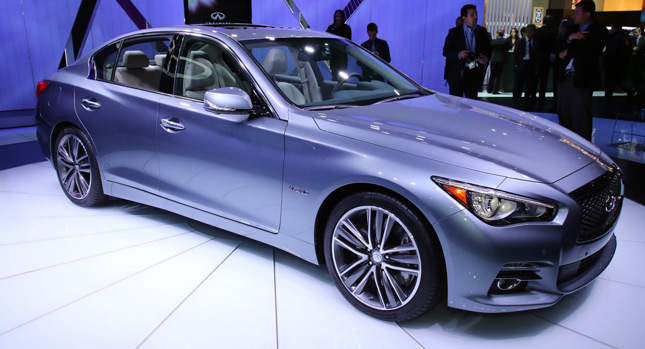The premium sports sedan segment is a hotly contested one, especially in the U.S. market. Infiniti’s novel contender in the class is the all-new Q50 that makes its debut at the 2013 Detroit Motor Show.
On the design front, the G37 replacement’s key features are the new “double arch” grille and “crescent-cut” C-pillar, both of which were first seen in the Essence concept that was displayed at the 2009 Geneva Auto Show. It also sports a side “character” line that integrates seamlessly with the LED taillights, narrower, roll-formed A- and B-pillars that provide easier access to the interior.
“The Infiniti Q50 reflects the direct influence of the concepts known as the ‘Infiniti Trilogy’, particularly the Essence” while honoring the iconic design dynamics of earlier Infiniti sports sedans”, said chief designer Shiro Nakamura. “The new Q50’s athletic and tightened appearance blends its lower and wider proportions with enhanced interior roominess to stunning effect inside and out.”
The Q50 is 4,783 mm (188.3 in) long, 1,824 mm (71.8 in) wide and 1,443 mm (56.8 in) tall and features a 2,850 mm (112.2 in) wheelbase. According to Infiniti, its aerodynamic drag coefficient (Cd) is just 0.26 and it has zero lift on both front and rear axles.
Infiniti’s new sports sedan will be offered initially in North America this summer with two powertrains. These include an all-aluminum 3.7-liter V6 with 328HP and 269 lb-ft (364.3Nm) of torque and a hybrid that links a 3.5-liter V6 gasoline engine with 302HP and 258 lb-ft (349.4Nm) of torque to an electric motor that generates 67HP and 199 lb-ft (269.5Nm) of torque, for a combined system output of 360HP.
Both powertrains are mated to a seven-speed automatic transmission with paddle shift control and are available in rear- and all-wheel drive versions. The Q50 has a multi-link suspension that makes extensive use of aluminum components on all four corners and rides on 17-inch alloy wheels with 225/55 run-flat tires or, optionally, 19-inch sport wheels with 245/45 rubber.
Steering is provided by a power-assisted vehicle-speed-sensitive rack-and-pinion system. However, the new Q50 also features an available Direct Adaptive Steering technology, which the Japanese brand says is a world-first design for a production vehicle. The system allows independent control of the car’s tire angle and steering input, with the company claiming that it transmits the driver’s actions faster than a traditional mechanical system. It offers four settings, allowing the driver to change steering effort and gear ratio, while a backup mechanical steering system is provided with models utilizing the new Direct Adaptive Steering technology.
Another world first is the Active Lane Control, which improves on the Lane Departure Prevention system by not only “reading” the road ahead through a camera located above the rear-view mirror, but also making slight steering input adjustments in case of direction changes due to road imperfections or crosswinds.
Being Red Bull Racing’s new title partner allowed Infiniti to ask for reigning Formula 1 world champion Sebastian Vettel and reserve test driver Sebastien Buemi to provide their feedback on the Q50’s handling, with Vettel driving the new sports sedan at the Tochigi track in Japan Buemi testing at the “old” Nürburgring.
https://youtube.com/watch?v=3ApyRvHIGak
PHOTO GALLERY







































